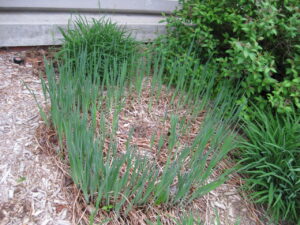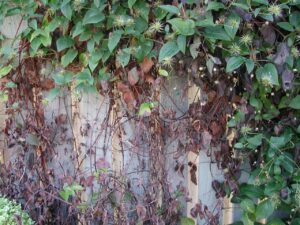Life Starts All Over Again When It Gets Crisp in the Fall
As the 2020 gardening yr draws to a close, at present is the time to ensure a successful gardening flavor next year, for you or your customers! Sanitation is a cornerstone of integrated pest management and is essential for skilful plant wellness management. Throughout the yr, we have been plagued with both unusually wet and unusually dry weather sometimes inside weeks of each other. This atmospheric condition incited unremarkably minor affliction issues to epidemic levels, encouraged the development of new disease issues and made for a difficult year to garden, specially for first fourth dimension gardeners. However, now is non the time to requite up!
Good sanitation, in the form of removing diseased plant material this autumn will help minimize or even prevent disease issues next spring. Many disease-causing organisms tin survive the wintertime in infected plant debris. Cutting back infected plants, disposing diseased plants (by burning or the garbage—do not compost!), or tilling under crop debris can besides help prevent over-wintering of plant illness causing organisms.
Evaluate and Investigate

Figure i. Failure to divide perennials tin result in crown rots.
Earlier you begin your sanitation program, bring out a notebook to have records of what did and did non work, what volition demand dividing in the spring, and what needs to be moved to a dissimilar site. Remember to accurately identify which pests you lot have and what crops they attack!
For numerous perennials, failure to separate is a leading cause of crown (Fig. 1). If y'all oasis't started a pest management, client 1000, or gardening log, consider doing so. Brand notes nearly issues and research potential solutions over the winter. Evaluate which varieties did well and which you lot should consider replacing. Did your rose defoliate in July? Look for the many affliction resistant roses or investigate what fungicides or insecticides yous may wish to purchase if you or your customer wants to keep the problem kid. The rose blackspot message can assist you with both. Was powdery mildew a problem for your bee-balm? Consider moving it to a sunnier location in the spring (with better air flow) or remove information technology and replace it with a powdery mildew resistant multifariousness, similar 'Jacob Cline', or many of the new, petite and illness resistant bee balms.
Get Downwardly and Dingy
After you've filled up several pages of notes, its time to put the notebook downwards, and put on the heavy gloves. Clean upwards leaves and crop residues from all gardens. Every bit soon as crops are harvested, pull up and dispose of all plant cloth, including roots. After a hard freeze, remove and compost all disease-free, merely frost-blackened, tender annuals , from African daisy to zinnia, and everything in between.
A mutual question asked past gardeners is whether diseased plants can be safely composted. The reply is NO! Practise not compost diseased plants! In Indiana (and most of the Midwest), compost rarely reaches the temperatures required to impale virtually plant pathogens. Be sure to discard the material properly, by bagging information technology or by burning it if this is permitted.
Did you take actually bad foliage spots on certain perennials? After your perennials take died dorsum, the leafy material tin can exist removed. Carefully cut the tissue with shears or pair of scissors and dispose of the infected leaves. Consider applying a chlorothalonil-based fungicide next year if leaf spots were particularly severe. Some diseases may require multiple applications for acceptable control. There are many common leafage diseases that skillful sanitation practices will help command, such as leaf spot of iris or botrytis of peony, to name a few. Cut back late flowering perennials like asters and chrysanthemums to a few inches. Did your peonies develop spots? Pull out the shears! Peonies can be cut to the ground, simply exist sure to remove all the infected foliage then information technology doesn't reinfect the new growth side by side year. Don't forget the mulch, or a row embrace to protect against freezing and thawing.

Figure 2. This year, many clematis across the state were infected with Ascochyta blight.
Clematis, "Queen of the Vines" commonly gets dethroned past a variety of fungal diseases, the nigh common and most serious of which is Ascochyta blight (Fig. 2). Remove infected vines and dispose of them. For some varieties, you lot may lose flowers, particularly if they flower on erstwhile wood (not usually grown in the Midwest, just at to the lowest degree you were warned). Mulch heavily with several inches of both soil and mulch—Because this disease unremarkably attacks at the soil line, by preserving the crown through deep planting or mulching, you can regenerate your clematis later on infection—fifty-fifty astringent infection, although the plant may take several years to recover. In the spring, consider preventative applications of a chlorothalonil based fungicide to minimize the likelihood of reinfection. If powdery mildew is also a trouble, be sure to add a FRAC 3 fungicide, similar Eagle/Systhane, Torque, Tourney, or Imprint Maxx.
Clematis isn't the just found to benefit from mulching: Add mulch to your perennials to create a protective layer that insulates plant roots from the freeze-thaw damage. Mulch as well conserves wet and improves soil construction. Straw, hay and compost are all excellent mulch materials. Leaves and grass clippings are less effective equally mulch material because neither holds much air infinite for insulation, merely the price is hard to beat! (Think in the coming spring to remove the mulch layer promptly, to forestall crown rots from occurring.)
Colorado Purple Bandbox Syndrome
Conserving moisture isn't enough, though. The dry out to drought-like conditions are setting copse and shrubs upwards for failure come spring. Be sure to thoroughly h2o all plants as we head into winter. Spruce, pine and other conifers specially can become desiccated by the harsh winter winds if a autumn drought should develop. When symptoms develop in the spring (purple Colorado blue spruce, reddish brown white pines and cherry pines), nothing can be done to "cure" the problem. While watering the bigger plants, don't forget sheltered perennials, such as those under the eaves, or nether the trees. Plants that get too dry in autumn are less likely to survive the wintertime. And you won't know this until the late spring when they fail to return!
Install unproblematic windbreaks, or embrace (Fig. three) the entire tree, or embrace the trunk of vulnerable, thin bark trees with plastic "tree guards." to protect them from drying winter winds. Anything that encourages snow accumulation will help provide splendid protection confronting low temperature or air current desiccation (Fig. 4). Questions regarding the utilize of anti-transpirants and evergreens need to exist put to residuum: Anti-transpirants are tools that help plants endure stressful, short-term periods, like transplant stupor. Simply the well-nigh hardcore lover of snow and ice could define an Indiana winter as "short term." For this reason, anti-transpirants are non a replacement for proper autumn watering or proper plant pick.
No Shears Hither
If in that location weren't enough chores in the grand this time of year, there is 1 you should not be doing: Pruning fruit copse. In climates such as ours, pruning should be done in spring just every bit the buds begin to swell. Freezing injury and dieback can occur to fruit trees if they are pruned in fall or early wintertime. Fifty-fifty though you can't prune, you can remove fallen fruits, or hanging "mummies" (dessicated, infected fruit that often serves as an inoculum source for next years infection). Don't forget to protect copse with mouse-vole/rabbit/deer guards. Wrap tree trunks with hardware cloth (¼ inch openings) upward to the expected snow-line to provide the necessary protection. Exist certain to remove this protection in the late spring to protect the crown of the tree as it continues to grow.
After the Bulbs of Summer Have Gone
Okay, that's non what Don Henley sang, but you get the idea. Don't forget to elevator and harvest tender bulbs and corms (cannas, caladiums, gladiolas, dahlias and tuberous begonias) for adjacent year. Lift after a good frost blackens their tops. Advisedly dig bulbs/corms and place the bulbs in a well-ventilated location to dry for a two- to three- calendar week flow. This will prevent storage rot from destroying your bulbs. Stems can be cut off with a sharp pocketknife or pair of scissors (except for begonias—keep reading!) near but not at the point where they sally from the bulb. Allow begonia stems to dry until they are breakable enough to pause off from the bulbs or cutting off the stems nearly 1 inch above the tubers. Place the tubers in a cool, dry area to cure for 2 to iii weeks. After curing, shop tubers between layers of peat moss or vermiculite. Shop bulbs in a absurd, dark place, that does not drop beneath 40 degrees F. Consider dusting the bulbs with a preventative fungicide, like captan or, Bordeaux or another copper to forbid storage rot. Consider pouring yourself a fine Bordeaux wine to toast yourself and all the piece of work that you've accomplished!
Lawns
Don't forget to rake and compost fallen leaves. Leaf litter left on lawn provides an infection court for snow mold. Be sure to sneak that terminal mowing in, too, equally long grass provides an excellent place for snow mold, too. Finally, fall is a corking fourth dimension to reduce weed levels—too, y'all want your fertilizer to go to the plants you dear. And unfortunately for me, no i wins prizes for growing the biggest dandelions!
All photos by Janna Beckerman.
martinezhazies1988.blogspot.com
Source: https://www.purduelandscapereport.org/article/life-starts-all-over-again-when-it-gets-crisp-in-the-fall-f-scott-fitzgerald/
0 Response to "Life Starts All Over Again When It Gets Crisp in the Fall"
إرسال تعليق